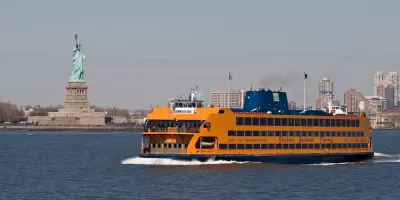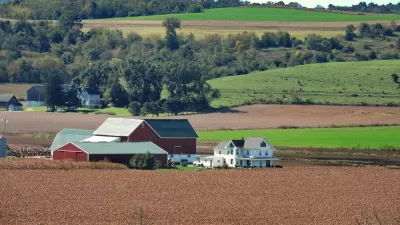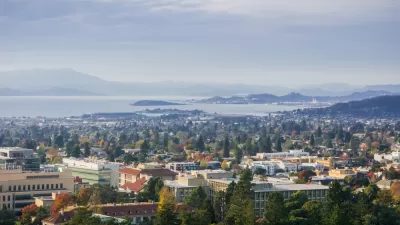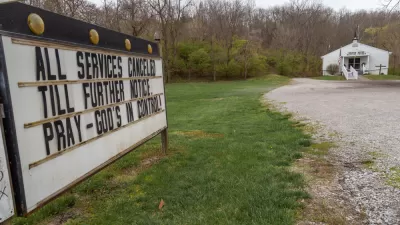Governors of three of the nation's largest states, containing the three largest cities, have issued emergency orders to slow the spread of COVID-19.

Updated March 21: Govs. Ned Lamont of Connecticut and Tom Wolf of Pennsylvania issued shutdown orders on Friday. On Saturday, New Jersey Gov. Phil Murphy issued a Stay at Home Order, closing all non-essential retail businesses effective at 9 p.m.
The dire orders by the three Democratic governors, Newsom (Calif.) on Thursday and by Cuomo (N.Y.) and Pritzker (Ill.) on Friday "come as Anthony S. Fauci, director of the National Institute of Allergy and Infectious Diseases, said Friday that Americans will need to stay at home as much as possible and maintain social distance from other people for at least several weeks to stem the spread of the virus," according to the Washington Post.
In his "must-see TV" daily coronavirus press briefing on Friday morning, Cuomo announced his PAUSE Executive Order, a 10-Point "Policy that Assures Uniform Safety for Everyone," with the first one being:
- Effective at 8 PM on Sunday, March 22, all non-essential businesses statewide will be closed;
A majority of the points ingrain social distancing behavior:
- Any concentration of individuals outside their home must be limited to workers providing essential services and social distancing should be practiced;
- When in public individuals must practice social distancing of at least six feet from others;
- Businesses and entities that provide other essential services must implement rules that help facilitate social distancing of at least six feet;
- Individuals should limit use of public transportation to when absolutely necessary and should limit potential exposure by spacing out at least six feet from other riders;
- Young people should also practice social distancing and avoid contact with vulnerable populations
In addition, it includes "Matilda's Law," named for his mother, which provides protections for 70+ year seniors and other "vulnerable populations." This may be the first COVID-19 directive that requires a portion of the population to wear masks and not to use public transit. This population is directed to:
- Wear a mask when in the company of others;
- Not take public transportation unless urgent and absolutely necessary.
And to "the greatest extent possible, everyone in the presence of vulnerable people should wear a mask."
“No, this is not life as usual,” Cuomo said as the death toll in the U.S. topped 200 on Friday, with at least 35 in his state, notes an AP article on the orders issued by the three governors. “Accept it and realize it and deal with it.”
Illinois
"To avoid the loss of potentially tens of thousands of lives, we must enact an immediate stay-at-home order for the state of Illinois," Gov. J.B. Pritzker said at a press conference, reported BuzzFeed.
"I fully recognize I am choosing between saving people's lives and saving people's livelihoods," Pritzker said, "but ultimately you can't have a livelihood if you don't have a life."
The governor issued a Disaster Proclamation that used California Gov. Newsom's term, "stay at home" or place of residence in his executive order [pdf]. "Pritzker said his latest decision was based on conversations with 'some of the best medical experts, epidemiologists, mathematicians and modelers,'" reported the Chicago Times. It took effect Saturday at 5 p.m. and continues "through at least April 7."
In short, residents who have heeded calls to work from home, maintain a social distance and repeatedly wash their hands will have no problem adjusting to the governor’s latest directive.
“For the vast majority of you already taking precautions, your lives will not change very much,” Pritzker said of the shelter-in-place directive.
The village of Oak Park outside Chicago had already issued at shelter-in-place order that took effect Friday.
Related in Planetizen:
-
The New Regionalism of the Coronavirus Pandemic, March 19, 2020
FULL STORY: Coronavirus stay-home orders apply to one in five Americans as confirmed cases are expected to skyrocket

Maui's Vacation Rental Debate Turns Ugly
Verbal attacks, misinformation campaigns and fistfights plague a high-stakes debate to convert thousands of vacation rentals into long-term housing.

Planetizen Federal Action Tracker
A weekly monitor of how Trump’s orders and actions are impacting planners and planning in America.

Chicago’s Ghost Rails
Just beneath the surface of the modern city lie the remnants of its expansive early 20th-century streetcar system.

Bend, Oregon Zoning Reforms Prioritize Small-Scale Housing
The city altered its zoning code to allow multi-family housing and eliminated parking mandates citywide.

Amtrak Cutting Jobs, Funding to High-Speed Rail
The agency plans to cut 10 percent of its workforce and has confirmed it will not fund new high-speed rail projects.

LA Denies Basic Services to Unhoused Residents
The city has repeatedly failed to respond to requests for trash pickup at encampment sites, and eliminated a program that provided mobile showers and toilets.
Urban Design for Planners 1: Software Tools
This six-course series explores essential urban design concepts using open source software and equips planners with the tools they need to participate fully in the urban design process.
Planning for Universal Design
Learn the tools for implementing Universal Design in planning regulations.
planning NEXT
Appalachian Highlands Housing Partners
Mpact (founded as Rail~Volution)
City of Camden Redevelopment Agency
City of Astoria
City of Portland
City of Laramie





























